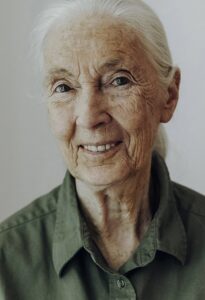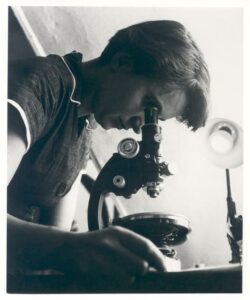Today marks a day of celebration for women in the United States. In case you didn’t know, Congress declared August 26th as Women’s Equality Day in 1920, in recognition of the ratification of the 19th Amendment. This constitutional amendment prevented the federal government and states from keeping people from voting based on sex; therein, establishing women’s right to vote.
Fortunate for female scientists like myself, woman’s equality in the workplace, civic arena, and in academia has grown in the past hundred years thanks to the contribution of many female pioneers.
Let’s take Marie Curie (Fig 1), the first woman to be awarded a Nobel Prize (and not just once, but twice!) Similarly, to another heroine previously-featured in InsideOut, Laura Bassi, Marie founded an underground university for women, where they could study physics, chemistry and mathematics.


Or, Jane Goodall (Fig 2), who had the interest, but not the money to attend university. She waited tables to save money to go on a trip to Kenya, where she impressed Louis Leakey, a prominent paleontologist, with her extensive knowledge of African animals. After this, Jane went on for her PhD at Cambridge University—one of only a few to be admitted without a Bachelor’s degree. In response to criticism regarding her scientific background and training, she has been quoted as saying, “I had never wanted to be a scientist anyway, as women didn’t have such careers in those days,” emphasizing the disparity between women and men in science in the 1960s that continues today.
Weaving a thread from her research in primates (e.g., offspring of mothers that are affectionate and supportive have high self-confidence), Goodall encourages us to recognize the benefits of feminine qualities on our science, and we should not always focus on behaving like men in order to be successful.
Rosalind Franklin’s niece shared a similar perspective about her aunt, who has often been touted as a feminist icon. She explained that Rosalind (Fig 3) would not have thought about herself in that manner. Franklin’s contribution to Watson and Crick’s landmark discovery of double-helix DNA through “Photo 51” was not known until 1968—10 years after her death. Rosalind thought of herself as a scientist whose contributions should be judged by their merit, and she just “happened” to be a woman.

This wise sentiment sounds a lot like Sally Ride’s perspective, another InsideOut heroine. Both women focused on doing the job for the job’s sake, not doing it better or first because they were women. Food for thought!
In closing, there is always more work to be done in this arena. At the Martinos Center, Women in Science, is dedicated to advancing equity in STEM as evidenced by their mission statement: “Generate thoughtful conversation about disparities in STEM related to gender & gender identity, culture, race, sexual orientation and background while providing tools and a safe environment to achieve equity” and subcommittee topics (i.e., education, LGBTQ+, Racial Justice, Policy Advocacy, and Social media. Follow them on Twitter to stay up to date and register to attend the second annual Martinos Center Summer Symposium (MCSS 2022), in-person on September 23, 2022 today. Keep your eye out for a future post with highlights from the symposium.
I’ll close with a quote from Representative Bella Abzug, who is credited with spurring the Congressional declaration of today as Women’s Equality, “The test for whether or not you can hold a job should not be the arrangement of your chromosomes.”
That’s your latest dose of InsideOut. Until next time, be well!
Contributed by: Natalie Gilmore
Sources:


